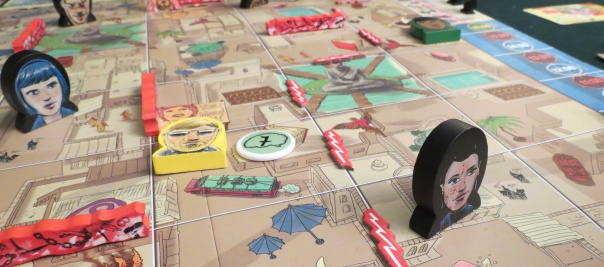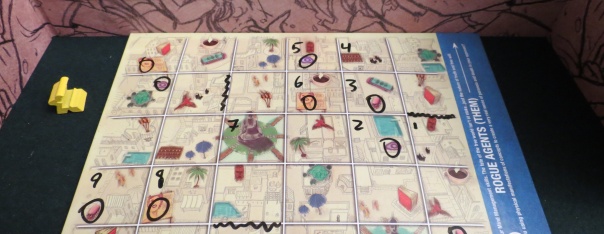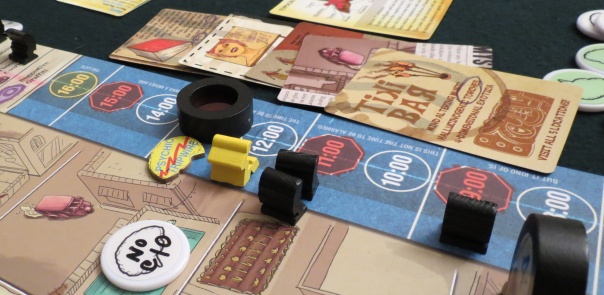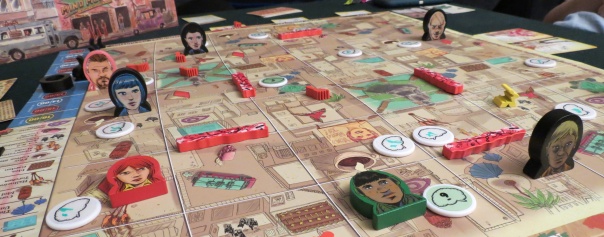Ceci n’est pas un Jeu de Société
It says so right there on the side of the box for Mind MGMT: “The Game of Calm and Relaxation. Where everyone wins.” Given the portrait that adorns the cover, of a woman partially shrouded by flames and implements of murder, one gets the sense that maybe this game isn’t being entirely forthright with its advertising.
The evidence keeps piling on. Hidden messages. Sinister warnings. Visual references to René Magritte’s La Trahison des Images. Much like the reality- and expectation-bending comic book series by Matt Kindt, Jay Cormier and Sen-Foong Lim’s version of Mind MGMT appears to be one thing only to soon reveal itself as something else. Before long, this state of constant metamorphosis proves to be the rule. You can barely hold it in place for all its writhing.
Hidden movement has always been the shiftiest mechanism in board gaming, both textually and as a tool of play. In the first case, because its usage implies the presence of something hidden, which naturally gives way to games of cat and mouse, cops and robbers, hunter and hunted. As a system, it replicates the thrill of the voyeur. To be aware where others are ignorant. To operate on the cusp of discovery. To slink where others stride. One can hardly play a hidden movement game — as the hunted, anyway — without feeling the prickle of the verboten as they slip once again between the seekers’ nets.
The second case is somehow yet more interesting: hidden movement is shifty because it’s the type of game that’s easiest to cheat.
I cheated once. The game was Tim Fowers and Jeff Krause’s Sabotage, a complex but endearing game in which two teams operate with little knowledge of the other. At first, the error was non-deliberate. Glancing up, I realized that in the reflection of the darkened window, that particular tableau — that exact cast of light, the seating of my foes, the placement of those oversized miniatures hidden behind their screen — was given life as a murky but legible scene. I looked away, abashed. Later, as my partner and I found ourselves on the verge of capture, my gaze strayed again toward the window. Guilt followed. But not before I read the reflection and spirited us out of danger.
Was it wrong? I think so. Even though I assumed our searchers would have returned the cheat had the opportunity offered itself. When one of them stood to get something from the kitchen, my partner and I huddled over our side of the board, making a shield with our bodies, even though he claimed he would look away as he walked past. It isn’t that we mistrusted him. Not exactly. It’s that we knew that some temptations are best avoided by being placed out of reach.
Mind MGMT is about cheating, albeit not in the overt sense I’ve been speaking about here. In a sense, you could even say that it is, itself, a cheat. One hunted, many hunters. A reliable formula. Except the formula is repeatedly inverted, contorted, bent into unrecognizable shapes. The core idea remains the same. One hunted, many hunters. Yet after a number of plays, I’m no longer certain which role I inhabit.
It begins subtly. Familiarly. Like a story you’ve heard before.
The hunted is a recruiter, sent to Zanzibar by an organization that hopes to… come to think of it, I’m not sure what they want. There are little details that scatter breadcrumbs of doubt: psychic powers, a single-use card featuring cryptographer dolphins, a map full of features named things like “subliminal billboard” and “observation monks.” Is it sinister or campy? Probably the latter, you figure. The hunted is here to contact recruits. Everybody else is a rogue agent. Onetime members of the organization. Now determined to put the whole thing to rest by capturing the recruiter before… the thing can happen.
As a game of cat and mouse, it doesn’t slouch. Everything revolves around those features, two per space. The recruiter has secretly drawn three feature cards; whenever he traverses a space with a matching feature, he earns a recruit. This entire route, from start to finish, is out of sight, scrawled on a miniature version of the map that can be wiped clean. The rogue agents, meanwhile, spend their time asking questions. When they visit a space, they can ask whether the recruiter has traveled by one of the features there. The recruiter places a footprint token on a matching feature he’s traveled past, or else answers that he hasn’t walked past a faraday mind-tree today. The hunters can then visit those footprints to discover when exactly the recruiter was there, gradually tracing a path and hopefully closing in on his position.
Yet there are other wrinkles. In addition to moving across the map, the recruiter also has four helpers called “immortals” who can also meet recruits. This leaks information to the rogue agents, often by indicating which cards the recruiter isn’t holding. That’s an obvious one. What makes Mind MGMT so devious is that nearly every action, question, or placed token leaks some kind of information. Even negative answers indicate that the recruiter hasn’t been here or there or there as of 13:00. This is especially useful because every single action matters. At the outset, the recruiter makes six full moves before the rogue agents give chase. This might sound unfair, but it effectively fast-forwards past the boring opening moves that are a staple of hidden movement games. It also means that the recruiter may have already made inroads toward winning the game before the game even begins. It’s an inversion, placing the rogue agents on the back foot and forcing them to scramble rather than establishing a proper grid search.
It’s also only the first of many, many inversions.
Here’s what happens.
When somebody wins, their victory instantiates somebody else’s defeat. Funny how that works. The losing team, whether recruiter or rogue agents, then opens one of fourteen boxes that are included in the game. Right away, this dulls the sharpness of defeat with the promise of new toys. What’s inside? Spoilers aren’t the usual remit of board game critique, but in this case some hesitancy seems appropriate. I’ll keep it limited to the first box or two, but skip to the final paragraph of this section if you want to be surprised.
Things change. And not only a little bit. The first rogue agent box unlocks a psychic tripwire. At any point during their turn, the rogue agents can arrange these tokens across the board, making a zigzag of lightning bolts. When the recruiter crosses that perimeter, they’re forced to disclose it — but not where they crossed. Nor even, since there’s a slight lag, exactly when. More information for the rogue agents, but imperfect information. Better still, information that grows more imperfect the longer the perimeter. So there’s a tradeoff. When should they deploy it? How wide a net should they cast? The tripwire becomes an important tool in their arsenal going forward, but it isn’t a trivial or straightforward power-up. Instead, the thing has edges. A clever recruiter might even be able to work it to his advantage.
Speaking of which, the recruiter’s first box is a distraction that can be placed on the board in lieu of a regular footprint. Much like the tripwire, this takes some smarts to use properly. It can be placed somewhere the recruiter hasn’t been, but too far off the mark and it’ll come across as an obvious ploy. Too near to the recruiter’s path and it might wind up helping the opposition, especially since many footprints will never be directly investigated.
These are game-changers. And they’re the tip of the iceberg. Within a few plays, players are forced to contend with wiped memories, clouded dreams, and new ways to move around, pursue their goals, and disrupt their foes. The core gameplay remains the same, but so altered that a newcomer could well find their head spinning. The effect is unsettling, even paranoid. Defeat becomes a cause for celebration. Victories become muted.
Of course, the full effect requires sequential plays, a far-fetched ask in a hobby climate that encourages bounding between experiences rather than reveling in them. Never mind that. I haven’t, anyway.
Earlier, I called it a cheat. I mean that affectionately. Mind MGMT is a game that can’t help but look into the darkened window, to turn the tables with each play, to make its searchers feel like hunters the way a rodent hunts a baited trap. It’s unbelievably generous, toying with ideas and expectations as wholeheartedly as its source material. None of its tricks would work if it weren’t a solid game to begin with. Thankfully, its heartwood is stout enough to bear all the rings that surround it. Mind MGMT is a masterwork that understands its mechanical genre — and elevates it.
(If what I’m doing at Space-Biff! is valuable to you in some way, please consider dropping by my Patreon campaign or Ko-fi.)
Posted on July 22, 2021, in Board Game and tagged Board Games, Mind MGMT, Off the Page Games, The Fruits of Kickstarter. Bookmark the permalink. 18 Comments.





Played it a couple weeks ago. Did the intro mission, and then one full-rule version. It was pretty enjoyable, especially for the recruiter (who was in place for both games and loved it). But once we finished and saw the unlocked cards, we were all itching to play again! Soon, I hope!
Great review! Thanks!
Thanks for reading, Jeff! I hope the next plays knock your socks off.
In addition to what has become my favourite hidden movement game, I must say that opening this box is like opening a Christmas present – the detail and quality of the box and (deluxe) components is refreshing and delightful
Agreed! I’m curious what the non-deluxe version looks like, because I hope it’s as delightful to dig into.
As always, a stellar review, Dan. Thank you.
I wish there were space in my collection for this one!
Thanks for reading, Ben.
Got this simply for the love of the comic series (I love Matt Kindt), but now I’m actually excited to play!
I’m reading Kindt’s series because of the game, and wow, it’s good.
Do you have the sense that this game can be played with people who don’t play a complicated board games? Folks that have mostly capped out at catan, codenames, and other more mainstream titles?
I figure the teach would be a bit longer which is fine but I question whether they would feel lost when actually in the game. The theme is very inviting so I am hoping to play it with less-serious-gamer types.
Sure, it could be played with relative newcomers. It includes various difficulty levels for that very reason, among them an introductory game that’s pared down to the absolute basics. Just don’t toss your friends into the deep end.
Pingback: Space-Cast! #14. Mind Managed | SPACE-BIFF!
Pingback: 10 games to try before GenCon 2021 ends! - Roll to Review
Pingback: Best Week 2021! Escape! Escape! | SPACE-BIFF!
Pingback: No County for Old Men | SPACE-BIFF!
Pingback: Bugpope and Spacegirl Hijack a Starship | SPACE-BIFF!
Pingback: Running Shoes Unlocked | SPACE-BIFF!
Pingback: AMBLE | SPACE-BIFF!
Pingback: Corpse of Discovery | SPACE-BIFF!